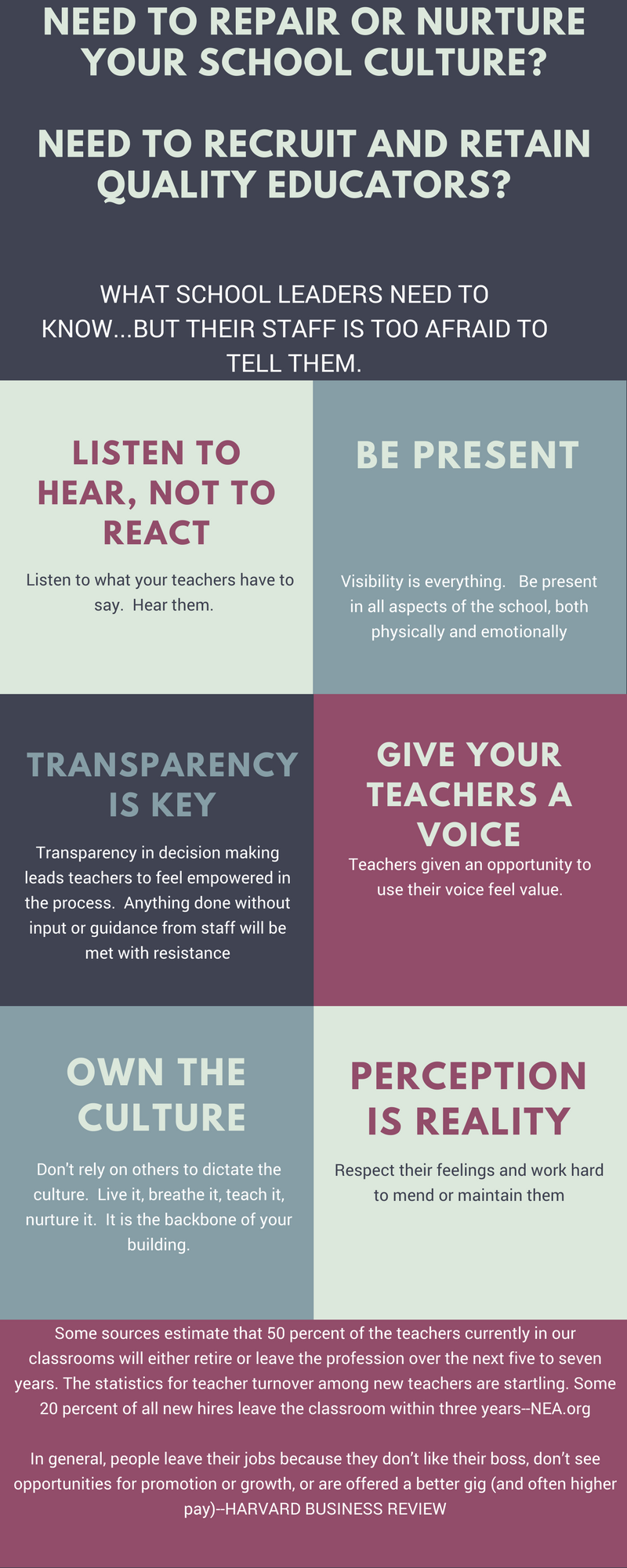One of the most famous movie quotes of all time is a perfect summarization of culture in schools.….”if you build it, they will come.” A positive school culture is not something that can happen overnight, but neither are gains in assessment results, or improvements in effective teacher recruitment and retention. They take work. Effective school leaders must be willing to put in the work to build their positive school culture. What type of school do you want to work in? Make it so. What kind of school do you want your children to attend? Make it so. Effective leaders cannot rely on a single committee or small group of people to drive their positive school culture. Culture has to be a intentionally thought out and planned and must be constantly evaluated by the leadership team. You can’t just throw a plate of cookies or donuts out on the faculty workroom table and think you’re doing right by the school culture.
Education is becoming more and more like a business. In the day and age of school choice and charter schools, educators and educational leaders that aren’t embracing leadership from a business perspective are falling behind. Students are the clients for which we are providing a service. Richard Branson’s philosophy of taking care of employees rings true in the world of education. He was quoted to say that “Clients do not come first, the employees come first. If you take care of your employees, they will take care of the clients.” In a roundabout way, this applies perfectly to school culture. Taking care of your employees is essentially taking care of the ultimate client; the students.
While working through the Kentucky CTEPS (Classroom Teachers Enacting Positive Solutions) project this year, I had the opportunity to survey teachers in various schools both through interviews and surveys. Additionally, I went back through district and school TELL survey results to determine how many schools had experienced turnover of staff as well as how many teachers were looking to leave their schools. In addition to TELL data, teachers within the school and across the district were willing to complete a survey and conduct one-on-one interviews to help gauge teacher views on school culture. Universally, data suggests that there is an increasingly high number of principal turnover. Even moreso, teacher turnover is occurring at rapid rates. According to an article in EdWeek, the average “lifespan” of a principal is less than five years.[1] In general, a principal is in their position for an average of three to five years before moving on to a district job, leaving for another school, or leaving the profession altogether. However, research suggests that it takes as many years to fully stabilize and improve the teaching staff as well as fully implement policies and practices to positively impact the school’s performance”[2]
School culture is a movement. It is a movement which must be led, nurtured, or repaired by the school leader. Much like this movement here. In the “first follower” movement, a person is seen dancing alone. Many onlookers aren’t sure what to think at first. But suddenly, someone follows. And then another. And another Until suddenly, there is a movement of dancers having a good time. All it takes is the first follower to see you take the first step...or the first dance. School leaders are charged with the task of leading a movement. Will you lead? Will you inspire the first follower?
So, what can a principal do to help repair or nurture a culture in that amount of time? How can principals support a culture that leads to teacher retention. How can a principal be the “first follower” in a movement to improve school culture and improve retention? Survey results lead to six major issues that teachers wanted their leaders to know, but were too afraid to say aloud. The following tips were shared during the one-on-one discussion and interviews from teachers across the district and within Kentucky.
[1] "Turnover in Principalship Focus of Research - Education Week." 26 Oct. 2009, http://www.edweek.org/ew/articles/2009/10/28/09principal_ep.h29.html.
[2] "The principal perspective: full report ...." http://www.centerforpubliceducation.org/principal-perspective.
Education is becoming more and more like a business. In the day and age of school choice and charter schools, educators and educational leaders that aren’t embracing leadership from a business perspective are falling behind. Students are the clients for which we are providing a service. Richard Branson’s philosophy of taking care of employees rings true in the world of education. He was quoted to say that “Clients do not come first, the employees come first. If you take care of your employees, they will take care of the clients.” In a roundabout way, this applies perfectly to school culture. Taking care of your employees is essentially taking care of the ultimate client; the students.
While working through the Kentucky CTEPS (Classroom Teachers Enacting Positive Solutions) project this year, I had the opportunity to survey teachers in various schools both through interviews and surveys. Additionally, I went back through district and school TELL survey results to determine how many schools had experienced turnover of staff as well as how many teachers were looking to leave their schools. In addition to TELL data, teachers within the school and across the district were willing to complete a survey and conduct one-on-one interviews to help gauge teacher views on school culture. Universally, data suggests that there is an increasingly high number of principal turnover. Even moreso, teacher turnover is occurring at rapid rates. According to an article in EdWeek, the average “lifespan” of a principal is less than five years.[1] In general, a principal is in their position for an average of three to five years before moving on to a district job, leaving for another school, or leaving the profession altogether. However, research suggests that it takes as many years to fully stabilize and improve the teaching staff as well as fully implement policies and practices to positively impact the school’s performance”[2]
School culture is a movement. It is a movement which must be led, nurtured, or repaired by the school leader. Much like this movement here. In the “first follower” movement, a person is seen dancing alone. Many onlookers aren’t sure what to think at first. But suddenly, someone follows. And then another. And another Until suddenly, there is a movement of dancers having a good time. All it takes is the first follower to see you take the first step...or the first dance. School leaders are charged with the task of leading a movement. Will you lead? Will you inspire the first follower?
So, what can a principal do to help repair or nurture a culture in that amount of time? How can principals support a culture that leads to teacher retention. How can a principal be the “first follower” in a movement to improve school culture and improve retention? Survey results lead to six major issues that teachers wanted their leaders to know, but were too afraid to say aloud. The following tips were shared during the one-on-one discussion and interviews from teachers across the district and within Kentucky.
- Listen to hear, not to react
- Give your teachers a REAL voice
- Transparency is KEY
- Be PRESENT
- Don’t rely on others. Take ownership of school culture
- Perception is reality
[1] "Turnover in Principalship Focus of Research - Education Week." 26 Oct. 2009, http://www.edweek.org/ew/articles/2009/10/28/09principal_ep.h29.html.
[2] "The principal perspective: full report ...." http://www.centerforpubliceducation.org/principal-perspective.
Alison Langley is a Special Education teacher and HCS Innovate Fellow in Hardin County Schools.



